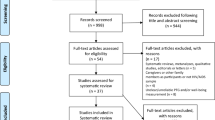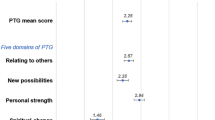Abstract
Rheumatoid arthritis (RA) is a chronic, deteriorative disease, which can cause great psychological distress. Although RA has negative psychological consequences, it may also lead to positive changes, which has been given relatively little attention in the research literature. The Posttraumatic Growth Inventory (PTGI) has been used to evaluate growth in survivor’s thinking, feeling and/or behavior following the experiencing of traumatic or severely adverse life events. The purpose of the current study was to examine the domains of the PTGI and to identify variables related to Posttraumatic Growth (PTG) in 117 RA patients from Turkey, a secular, Islamic, non-western developing country. Results showed that the PTGI has three domains: relationship with others; philosophy of life; and self-perception. Regression analyses showed that problem-focused coping had significant contributions to the total PTG levels and PTGI domains of relationship with others and self-perception. Perceived social support appeared as a significant associate for the total PTG levels and for all three domains. In addition, age and perceived disease severity were found to be significantly related to some domains of PTG. Clinicians, aiming to increase positive experience of RA patients, may need to focus on and facilitate perceived social support and problem-focused coping to facilitate growth experiences.
Similar content being viewed by others
References
Abraido-Lanza, A. F., Guier, C., & Colon, R. M. (1998). Psychological thriving among Latinos with chronic illness. Journal of Social Issues, 54, 405–424.
Alamanos, Y., & Drosos, A. (2005). Epidemiologist of adult rheumatoid arthritis. Autoimmunity Reviews, 4, 130–136.
Aldwin, C. M., Sutton, K., & Lachman, M. (1996). Development of coping resources in adulthood. Journal of Personality, 64, 837–871.
Altan, L., Bingöl, Ü., Sağırkaya, Z., Sarandöl, A., & Yurtkuran, M. (2004). Romatoid artritli hastalarda anksiyete ve depresyon (Anxiety and depression in rheumatoid arthritis patients). Romatizma, 19, 7–13.
American Psychiatric Association. (2000). Diagnostic and statistical manual of mental disorders (DSM-IV-TR) (4th ed.). Washington, DC: Author.
Anderson, K. O., Bradley, L. A., Young, L. D., McDaniel, L. K., & Wise, C. M. (1985). Rheumatoid arthritis: Review of psychological factors related to etiology, effects, and treatment. Psychological Bulletin, 98, 358–387.
Aydemir, Ö. (1997). Hastane Anksiyete ve depresyon ölçeği Türkçe formunun geçerlilik ve güvenilirlik çalışması (Reliability and validity study of Hospital Anxiety and Depression Scale). Turkish Journal of Psychiatry, 8, 280–287.
Bellizzi, K. M., & Blank, T. O. (2006). Predicting posttraumatic growth in breast cancer survivors. Health Psychology, 25, 47–56.
Bradley, L. A., McKenree-Smith, N. L., & Cianfrini, L. R. (2003). Cognitive-behavioral therapy interventions for pain associated with chronic illnesses. Seminars in Pain Medicine, 1, 44–54.
Cadell, S., Regehr, C., & Hemsworth, D. (2003). Factors contributing to posttraumatic growth: A proposed structural equation model. American Journal of Orthopsychiatry, 73, 279–287.
Calhoun, L. G., Cann, A., Tedeschi, R., & McMillan, J. (2000). A correlational test of the relationship between posttraumatic growth, religion, and cognitive processing. Journal of Traumatic Stress, 13, 521–527.
Calhoun, L. G., & Tedeschi, R. G. (2000). Early posttraumatic interventions: Facilitating possibilities for growth. In J. M. Violanti., D. Paton., & C. Dunning (Eds.), Posttraumatic stress intervention: Challenges, issues, and perspectives (pp. 135–152). Springfield: Charles Thomas.
Carver, C. S. (1998). Resilience and thriving: Issues, models, and linkages. Journal of Social Issues, 54, 245–266.
Cordova, M. J., Cunningham, L. L. C., Carlson, C. R., & Andryowski, M. (2001). Posttraumatic growth following breast cancer: A controlled comparison study. Health Psychology, 20, 176–185.
Crystal, L. P., & Amy, L. I. (2006). Meaning making and growth: New directions for research on survivors of trauma. Journal of Loss and Trauma, 11, 389–407.
Eker, D., & Arkar, H. (1995). Çok boyutlu algılanan sosyal destek ölçeğinin factor yapısı, geçerlilik ve güvenirliği (The factorial structure, reliability and validity of Multidimensional Social Support Scale). Turkish Journal of Psychology, 34, 45–55.
Elçi, Ö. (2004). Predictive values of social support, coping styles and stress level in posttraumatic growth and burnout levels among the parents of children with autism. Unpublished master’s thesis. Middle East Technical University, Ankara, Turkey.
Folkman, S., & Lazarus, R. S. (1985). If changes it must be a process: Study of emotion and coping during three stages of a college examination. Journal of Personality and Social Psychology, 48, 150–170.
Frazier, P., Conlon, A., & Glaser, T. (2001). Positive and negative life changes following sexual assault. Journal of Consulting & Clinical Psychology, 69, 1048–1055.
Freedy, J. R., & Hobfoll, S. E. (1994). Stress inoculation for reduction of burnout: A conservation of resources approach. Anxiety, Stress, and Coping, 6, 311–325.
Green, S. B., Salkind, N. J., & Akey, T. M. (1997) Using SPSS for windows. New Jersey: Prentice Hall.
Janoff-Bulman, R. (1992). Shattered assumptions: Towards a new psychology of trauma. New York: Free Press.
Kağıtçıbaşı, Ç. (1996). Individualism and collectivism. In J. W. Berry, M. H. Segall, & Ç. Kağıtçıbaşı (Eds.), Handbook of cross-cultural psychology (pp. 1–49). London: Allyn and Bacon.
Karanci, A. N., & Acarturk, C. (2005). Post-traumatic growth among Marmara earthquake survivor involved in disaster preparedness as volunteers. Traumatology, 11, 307–323.
Karanci, A. N., Akşit, B., & Dirik, G. (2005). Impact of community disaster awareness training program in Turkey: Does it influence hazard-related cognitions and preparedness behaviors. Social Behavior and Personality, 33, 243–258.
Karanci, A. N., Alkan, N., Akşit, B., Sucuoğlu, H., & Balta, E. (1999). Sex differences in psychological distress, coping, social support and related variables following the 1995 Dinar (Turkey) earthquake. North American Journal of Psychology, 1, 189–204.
Karanci, A. N., & Dirik, G. (2003). Predictors of pre- and postoperative anxiety in emergency surgery patients. Journal of Psychosomatic Research, 55, 363–369.
Karanci, A. N., & Erkam, A. (2007). Variables related to stress-related growth among Turkish breast cancer patients. Stress and Health, 23(5), 315–322.
Kesimci, A. (2003). Perceived social support, coping strategies and stress-related growth as predictors of depression and hopelessness in breast cancer patients. Unpublished master’s thesis. Middle East Technical University, Ankara, Turkey.
Kesimci, A., Göral, F. S., & Gençöz, T. (2005). Determinants of stress-related growth: Gender, stressfulness of the event, and coping strategies. Current Psychology: Developmental, Learning, Personality, Social, 24, 68–75.
Kılıç, C. (2005). Posttraumatic growth and its predictors. Paper presented at the IV. International Psychological Trauma Meeting, İstanbul.
Kuguoglu, S., Aslan, F. E., & Icli, G. (2006). Are patients in western Turkey contented with health care services? Journal of Nursing Care Quality, 21, 366–371.
Linley, P. A., & Joseph, S. (2004). Positive change following trauma and adversity. A review. Journal of Traumatic Stress, 17, 11–21.
Lorig, K., Chastain, R. L., Ung, E., Shoor, S., & Holman, H. R. (1989). Development and evaluation of a scale to measure perceived self-efficacy in people with arthritis. Arthritis and Rheumatology, 32, 37–44.
Meenan, R., Mason, J., Anderson, J., Guccione, A., & Kazis, L. (1992). The content and properties of a revised and expanded arthritis impact measurement scales health status questionnaire. Arthritis & Rheumatism, 35, 1–10.
O’Leary, V. E., & Ickovics, J. R. (1995). “Resilience and thriving in response to challenge: An opportunity for a paradigm shift in women’s health”. Women’s Health: Research on Gender, Behavior, and Policy, 1, 121–142.
Park, C. L., Cohen, L. H., & Murch, R. (1996). Assessment and prediction of stress-related growth. Journal of Personality, 64, 71–105.
Park, C. L., & Fenster, J. R. (2004). Stress-related growth: Predictors of occurrence and correlates with psychological adjustment. Journal of Social and Clinical Psychology, 23, 195–215.
Pincus, T., Griffith, J., Pearce, S., & Isenberg, D. (1996). Prevalence of self-reported depression in patients with rheumatoid arthritis. British Journal of Rheumatology, 35, 879–883.
Polantinsky, S., & Esprey, Y. (2000). An assessment of gender differences in the perception of benefit resulting from the loss of a child. Journal of Traumatic Stress, 13, 709–718.
Powell, S., Rosner, R., Butollo, W., Tedeschi, R. G., & Calhoun, L. G. (2003). Posttraumatic growth after war: A study with former refugees and displaced people in Sarajevo. Journal of Clinical Psychology, 59, 71–83.
Sheikh, A. I. (2004). Posttraumatic growth in the context of hearth disease. Journal of Clinical Psychology in Medical Settings, 11, 265–273.
Siva, A. N. (1991). Infertilite’de stresle baş etme, öğrenilmiş güçlülük ve depresyonun incelenmesi (Coping with stress, learned powerfulness, and depression among infertile people). Unpublished doctoral dissertation, Hacettepe University, Ankara.
Tedeschi, R., & Calhoun, L. (1995) Trauma and transformation. Thousand Oaks, CA: Sage.
Tedeschi, R. G., & Calhoun, L. G. (1996). The Posttraumatic Growth Inventory: Measuring the positive legacy of trauma. Journal of Traumatic Stress, 9, 455–471.
Tedeschi, R. G., Park, C. L., & Calhoun, L. G. (1998). Posttraumatic growth: Conceptual issues. In R. G. Tedeschi, C. L. Park, & L. G. Calhoun (Eds.), Posttraumatic growth: Theory and research on change in the aftermath of crisis (pp. 1–22). Matwah, NJ: Lawrence Erlbaum.
Updergraff, J. A., Taylor, S. E., Kemeny, M. E., & Wyatt, G. E. (2002). Positive and negative effects of HIV infection in women with low socio-economic resources. Personality and Social Psychology Bulletin, 28, 382–394.
Weiss, T. (2002). Posttraumatic growth in women with breast cancer and their husband: An intersubjective validation study. Journal of Psychosocial Oncology, 20, 65–80.
Widows, M. R., Jacobsen, P. B., Booth-Jones, M., & Fields, K. K. (2005). Predictors of posttraumatic growth following bone marrow transplantation for cancer. Health Psychology, 24, 266–273.
Zigmond, A. S., & Snaith, R. P. (1983). The Hospital Anxiety and Depression Scale. Acta Psychiatrica Scandinavica, 67, 361–370.
Zimet, G. D., Dahlen, N. W., Zimet, S. G., & Forley, G. K. (1988). The Multidimensional Scale of Perceived Social Support. Journal of Personality Assessment, 52, 30–45.
Acknowledgements
This work was supported by the Middle East Technical University, Applied Research Fund.
Author information
Authors and Affiliations
Corresponding author
Rights and permissions
About this article
Cite this article
Dirik, G., Karanci, A.N. Variables Related to Posttraumatic Growth in Turkish Rheumatoid Arthritis Patients. J Clin Psychol Med Settings 15, 193–203 (2008). https://doi.org/10.1007/s10880-008-9115-x
Received:
Accepted:
Published:
Issue Date:
DOI: https://doi.org/10.1007/s10880-008-9115-x




